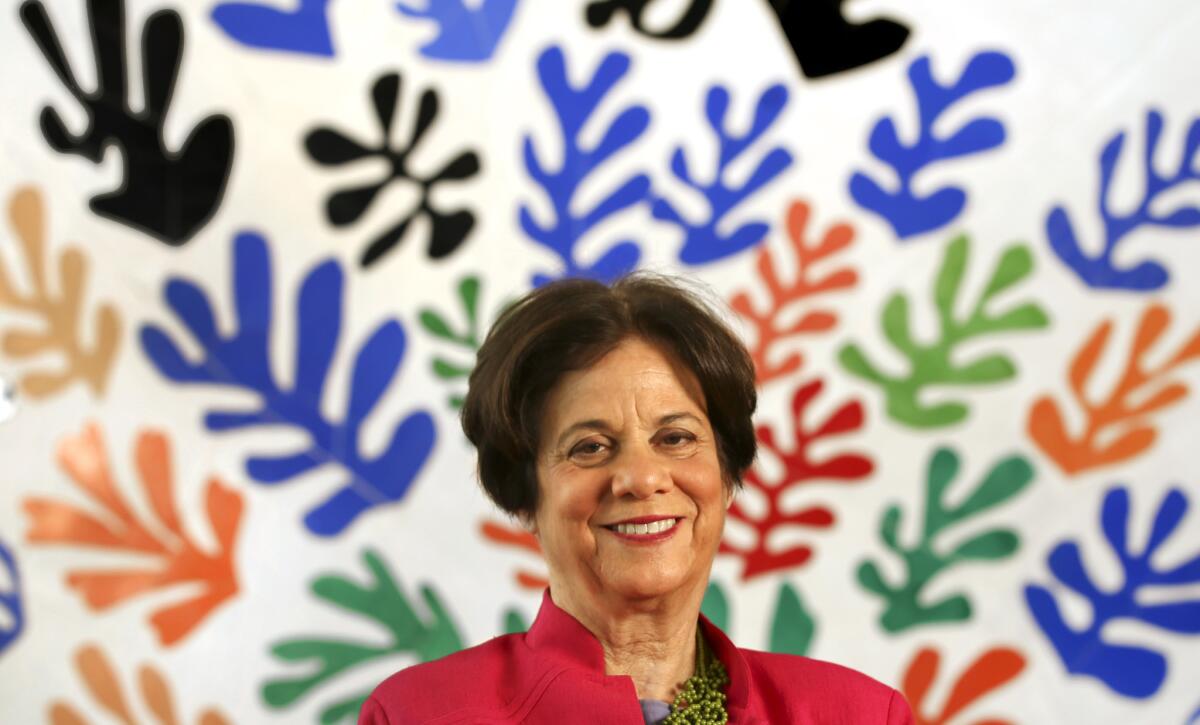Curator Stephanie Barron has grown along with LACMA

- Share via
Inside Stephanie Barron’s glass-walled office, cluttered with memories of her nearly 40 years at the Los Angeles County Museum of Art, there’s a tacked-up printout of the 2014 portrait painter David Hockney created in her honor. Within arm’s reach is a well-thumbed catalog from “Degenerate Art: The Fate of the Avant-Garde in Nazi Germany,” the groundbreaking exhibition she produced for LACMA in 1991.
And taped to a shelf is an email from architect Frank Gehry. “I love workin wit yu,” the message reads, its abbreviated informality the mark of a friendship that extends more than three decades.
FULL COVERAGE: LACMA at 50
Gehry has masterminded the installation design on half a dozen LACMA shows curated by Barron, from “Degenerate Art” to the 2013 exhibition devoted to sculptor Alexander Calder.
“If she works with other designers on other shows, I don’t want to know about it,” Gehry jokes. “If she’s cheating on me, don’t tell me! We have fun doing it. And so far we’ve been crackers at nailing it.”
Over her career, Barron has been part of the team that has helped LACMA grow from regional encyclopedic museum with a focus on American and European art to global institution with budding collections of Korean, Islamic and Latin American art. She has been there for the museum’s moments of triumph but also its rough patches — such as the countywide fiscal crisis of the early 1990s, during which the museum was in danger of losing its government funding. (“The economic situation was bleak,” she remembers. “We were closed two days a week, and we were closing galleries on a rotating basis. I realized how fragile institutions can be.”)
But in 1976, when Barron was offered a job as associate curator at LACMA, she almost didn’t come. A native New Yorker, she debated whether it’d be a good idea to leave graduate school for an uncertain position across the country from the Manhattan art world. At that point, she’d been to Los Angeles only once, on a family trip at age 10.
“And I had the typical New Yorker reaction to it,” she says. “There was a beach and some orange groves. I didn’t even make it to Disneyland.”
The opportunity to play an important role at a young institution, however, inspired Barron to ditch her dissertation at the City University of New York and head West. In the event that things didn’t work out, she held on to her New York apartment. “I thought, ‘I’ll only be here three years,’” she recalls, “‘and then I’ll do something else.’”
Except that “something else” has always been at LACMA.
“I’ve had the amazing good fortune,” Barron reflects from inside her cozy book-lined den, “to work for an institution that has unconditionally supported the seriousness of the work that I want to do.”
When she first arrived as an associate curator for LACMA, Barron was one of five people working in a department that produced all of the museum’s Modern and Contemporary programming. Now there are five staffers alone for the Modern art department, which she oversees as senior curator and department head.
Not one to chase easy, crowd-pleasing blockbusters about Impressionists in the South of France, Barron, by focusing her sights on shows that dig deep and synthesize complicated ideas, is one of this country’s curatorial forces.
Her breakout was the heady 1980 exhibition “The Avant-Garde in Russia, 1910-1930: New Perspectives,” which she organized with her boss, senior curator Maurice Tuchman. The show brought together a staggering 450 works from the decade after the Russian Revolution, when artists such as Kazimir Malevich, El Lissitzky and Wassily Kandinsky were experimenting wildly with forms as well as theories.
Similarly challenging shows have followed. Barron has helped organize exhibitions about the ways in which California has been depicted in American visual culture. She has examined the work of East and West German artists laboring at the height of the Cold War. And she has looked at the lasting influence of Belgian surrealist painter René Magritte on a generation of 20th century artists — a show that was wryly and imaginatively installed by L.A. conceptualist John Baldessari.
But the project of which she is proudest is the 1991 history-making “Degenerate Art: The Fate of the Avant-Garde in Nazi Germany.” Through years of painstaking research and no small amount of curatorial wheedling, Barron was able to assemble 175 of the 650 works shown by the Nazis in an infamous 1937 display of pillaged art whose aim was to discredit Modernism and the artists of the German Expressionist movement, figures such as Ernst Ludwig Kirchner, Paul Klee and Otto Dix.
“This was an exhibition that the Nazis had mounted to excoriate Modern art,” she explains. But much of the information about it had been lost. “There was so much detective work.”
Barron had stumbled into the concept after spying a rare photograph of a German Expressionist sculpture that had been in the Nazi show. Intrigued, she dug deeper. Her research led her to a library in East Berlin in 1986 — at a time when Germany was still split by Cold War politics. There, she located a cache of photographs that documented the contents of the Nazi show.
The challenge: She was forbidden from taking pictures or make photocopies of the images.
“So for 10 days, I sat there with a sketch pad and a pencil and I drew every photograph,” she says. “That show, I just sweated bullets to make it happen.”
Reviewing “Degenerate Art” in The Times in 1991, critic William Wilson wrote: “Dense with thought and feeling, the exhibition will surely join the ranks of the most important ever mounted.” The show and its catalog won multiple awards.
Gehry designed the installation for that exhibition — which included a model of the original Nazi show — despite being occupied with his booming architectural practice. (He had just won the Pritzker Prize in 1989.)
“These days, I don’t need to spend time doing shows at the L.A. County Museum,” he says. “But I do it because I enjoy working with Stephanie.”
“She isn’t a know-it-all,” he explains. “She comes in with honest questions and is willing to explore ideas. ... It’s always a new wrinkle in understanding.”
Barron says she felt particularly privileged to work with Gehry on the 2012 retrospective of the dappled, otherworldly forms of ceramist Ken Price, who was dying as the show was laid out.
“It gave these two friends something incredibly beautiful to do together,” she says. “Before he died, Ken was able to see how every piece would be installed.”
For a time, Barron took on administrative roles at LACMA in addition to her curatorial duties. But she went back to curating full time in 2003 — it’s her true passion. Though she technically reports to senior deputy director Nancy Thomas, Barron says LACMA Director Michael Govan has an open-door policy when it comes to curatorial.
“He’s really smart, he has a good eye and I trust his instincts — I often like to bat an idea around with him,” she says. “Michael seems to have a lot of respect for my work and is tremendously supportive.”
Maybe that’s because Barron’s influence goes well beyond the temporary exhibition program. She has helped shape the permanent collection and found innovative ways of presenting it in the museum’s galleries. LACMA, for instance, opens its permanent collection galleries not with 19th century French paintings or Italian Renaissance art, but Austrian and German Expressionist works from the early 20th century, which in many ways tie in to the World War II-era European exile culture of Los Angeles. But her most significant achievement in this area is bringing a priceless private collection into the museum’s holdings.
Since the 1970s, Barron had socialized with Henri and Janice Lazarof. He was a composer (who has since died); she was the daughter of financier and real estate mogul Mark Taper (the one who has a downtown auditorium in his name). Over the course of their friendship with Barron, the couple began collecting art: sculptures by Alberto Giacometti, paintings by Kandinsky, works by Picasso and Matisse.
“I watched the collection grow,” says Barron. “I would have dinner there about once a month and I would ask, ‘Anything new?’ And they’d say, ‘Look around.’”
Over the years, she says she was careful never to suggest how they might build or dispose of their collection, nor did she breathe word of its existence to anyone else. “They were ultra private,” says Barron. “They didn’t lend works, and they weren’t part of the art world. I’d met them through family friends.”
One evening she arrived at their home to discover that they had acquired a second version of Constantin Brancusi’s 1920s bronze sculpture “Bird in Space” — a piece that is a touchstone in the development of Modern art. Barron says she was floored when she saw it. LACMA, at the time, didn’t have a single Brancusi to its name.
“Who has one Brancusi? Much less two? In different sizes?” she exclaims. “And I blurted out, ‘This would be terrific in the museum!’ To my surprise they didn’t ask me to leave.”
And thus begun a series of quiet conversations that eventually led the Lazarofs to donate their collection to LACMA: 130 works by major artists, including 20 pieces by Picasso, seven sculptures by Giacometti and the two versions of “Bird in Space.”
“We bandy the word ‘transformative’ around a lot,” says Barron. “But this really transformed our Modern holdings.”
In all of this, Barron has found time to enjoy the quiet, personal moments L.A. has given her: hiking in the Santa Monica Mountains and cooking elaborate New Year’s dinners with her 26-year-old son, Max. And there are the many friendships she has cultivated. “Part of the privilege of being a curator is getting close to the artists,” she says, “If I’m having a crummy day, I call David Hockney and ask if I can do a studio visit. It’s a thrill to go there. I always learn something.” This is a sentiment he returns: “She has always followed my work and what I’m doing,” he states via email. “We are great friends.”
But just because she has an accomplished career to her credit doesn’t mean that Barron is taking a break. In fact, she is knee-deep in preparing a retrospective on Gehry’s architecture, which opens in September. The following month, she will debut an exhibition about German art during the Weimar Republic — nearly 200 works by some 50 artists — that will chronicle the destabilizing era after World War I, a period of rapid industrialization and high unemployment but also widespread cultural achievement.
In 1988, The Times published a profile of Barron that described her as a curator “who likes nothing better than to bring craggy mountains of art to people who prefer soft fields of flowers.”
Asked how she feels about the characterization today, she says with a chuckle, “I think it’s still true.”
Twitter: @cmonstah
More to Read
The biggest entertainment stories
Get our big stories about Hollywood, film, television, music, arts, culture and more right in your inbox as soon as they publish.
You may occasionally receive promotional content from the Los Angeles Times.










